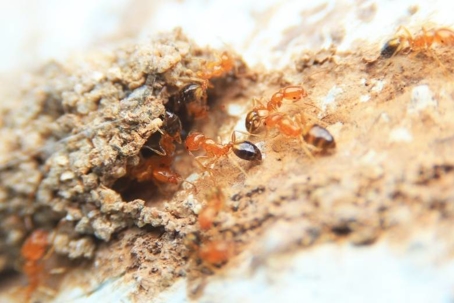What Can Citronella Ants Eat?
Citronella ants are attracted primarily to sweet foods, similar to other small ants. Their diet typically includes:
Sugars and sweet substances: Honey, syrup, nectar, fruit juices, and sugary snacks.
Plant secretions: Some may feed on plant sap or honeydew produced by aphids.
Small insects or protein sources: They may occasionally consume dead insects or protein-rich foods to meet their nutritional needs, especially when raising larvae.
Household scraps: Crumbs, pet food, and other accessible sweet or protein-rich items.
They are not very picky but are strongly drawn to sugar and sweet liquids, which is often how infestations begin indoors.
For effective control, eliminating access to these food sources and maintaining clean surfaces and sealed containers is critical.
What Do Citronella Ants Eat?
Citronella ants generally prefer sweet foods over protein or greasy foods. Their strongest attraction is to:
Sugary substances: sugar, honey, syrup, nectar, fruit juices, and other sweet liquids.
Plant-based sources: sap, honeydew from aphids, and other sugary excretions from plants.
Protein sources like small insects or meat are usually secondary—they’ll consume them if available, but sweets dominate their foraging behavior.
Their preference for sugary foods is a key reason why sugar-based baits are usually most effective when controlling them indoors.
Do Citronella Ants Eat Insects?
Citronella ants are primarily sugar feeders, but they will opportunistically consume small insects, particularly when protein is needed for larval development. Insects they might eat include:
Soft-bodied insects such as aphids, small caterpillars, or tiny larvae of other insects.
Dead insects (necrophagy), including small flies, ants, or other arthropods they encounter.
Occasionally, egg clusters or pupae of other small insects if accessible.
They usually target insects that are small, slow, or immobilized, rather than actively hunting large, fast prey. Protein from these sources supplements their diet but is not their primary preference.
Do Citronella Ants Eat Animals?
Citronella ants do not typically prey on animals in the way predators do. Their diet is mostly sugar- and plant-based, but they will opportunistically consume very small or immobile animals when available, primarily to obtain protein for larvae. This includes:
Small insects (like aphids, tiny caterpillars, or other arthropods).
Dead or incapacitated insects.
Occasionally, very small invertebrates such as mites or springtails.
They generally do not attack larger animals—their “animal” diet is limited to tiny invertebrates that can be subdued or scavenged. Their protein intake is mostly supplemental to their primary sugary diet.
Do Citronella Ants Eat Plants?
Citronella ants do not directly eat plants in the traditional sense—they are not herbivores that chew leaves or stems. However, they are strongly attracted to plant-derived sugary secretions. Plants may be involved in their diet in these ways:
Honeydew from sap-sucking insects: Ants often “farm” aphids, mealybugs, or scale insects that feed on plant sap, collecting the honeydew they excrete.
Nectar: Flowers producing nectar can attract them for the sugary liquid.
Fruits: Overripe or damaged fruits that release juices are highly attractive.
Exudates from damaged plant tissue: Any sugary sap leaking from cuts, wounds, or decaying plant matter.
They generally do not eat leaves, roots, or stems, but any part of a plant that produces or leaks sugar can become a food source.

